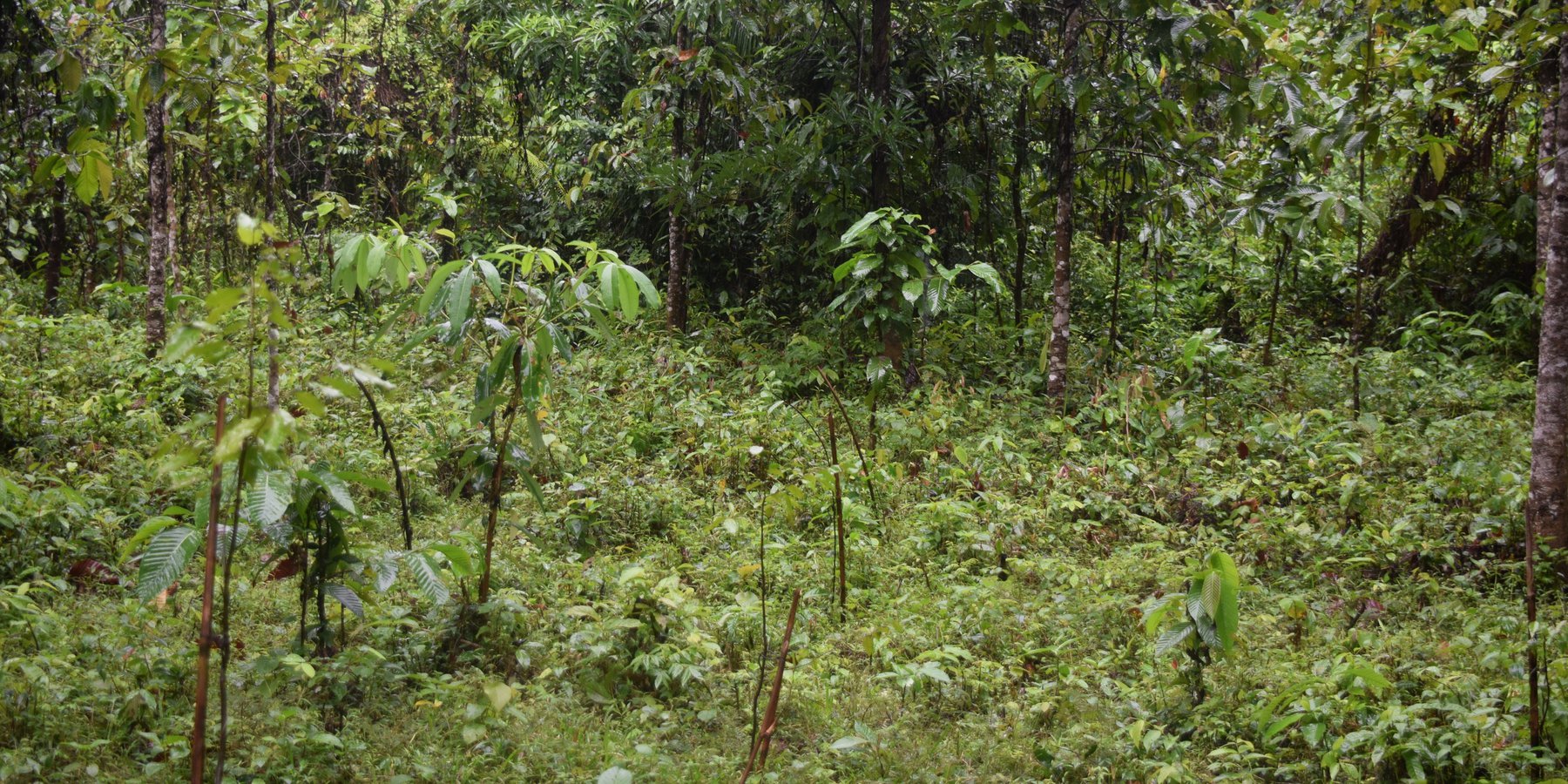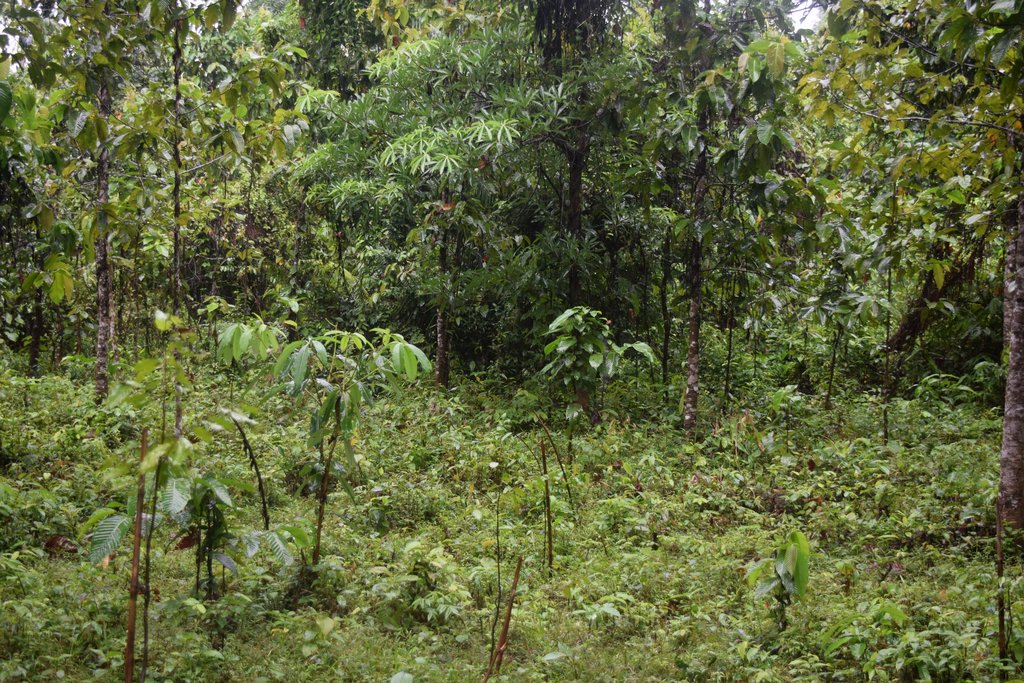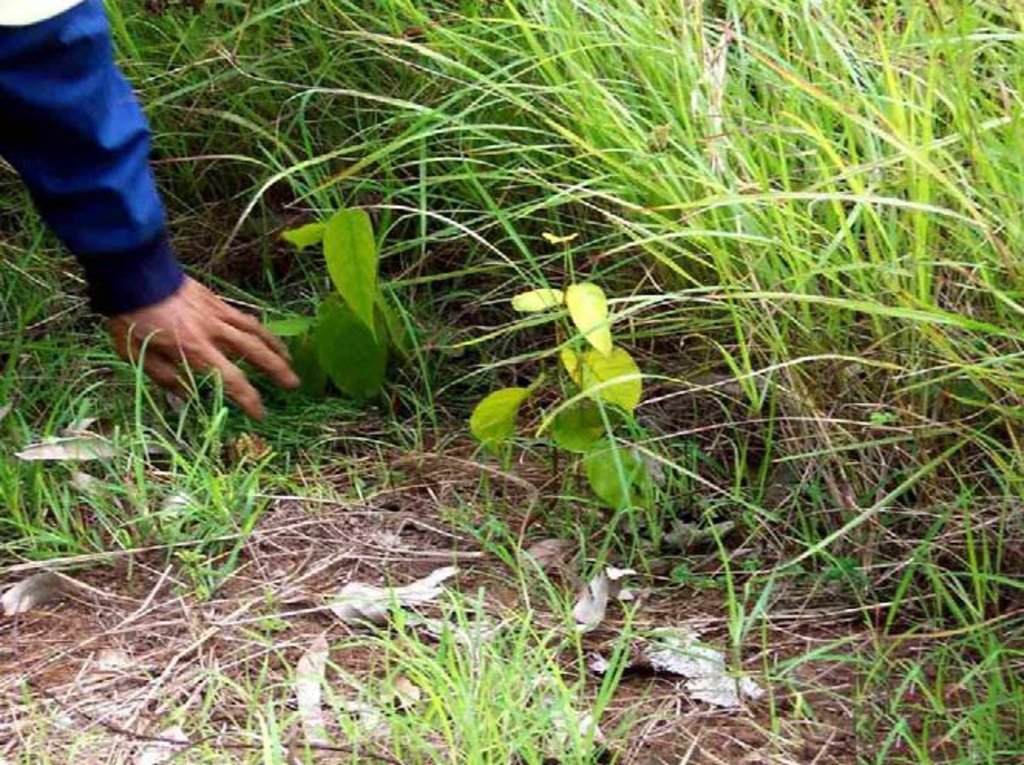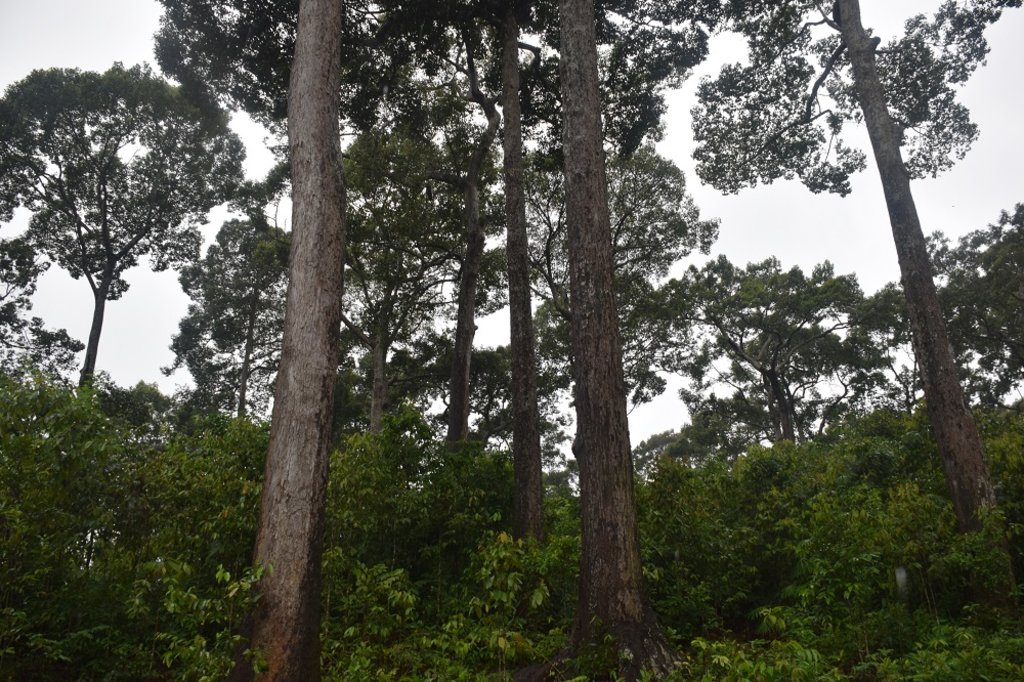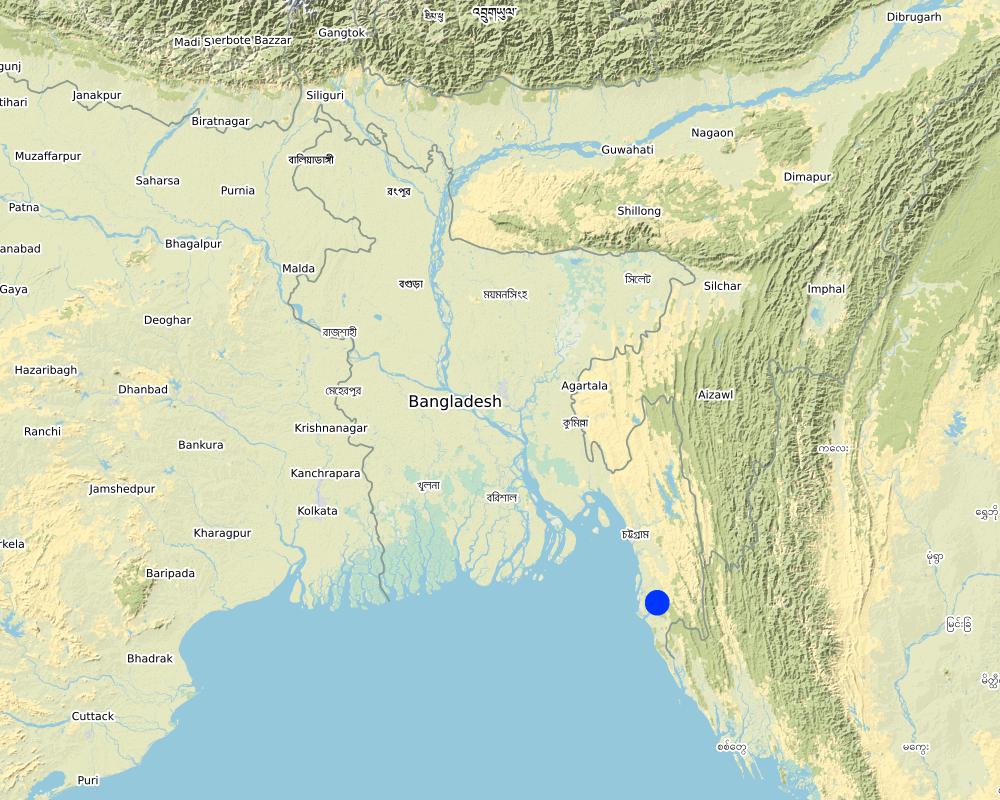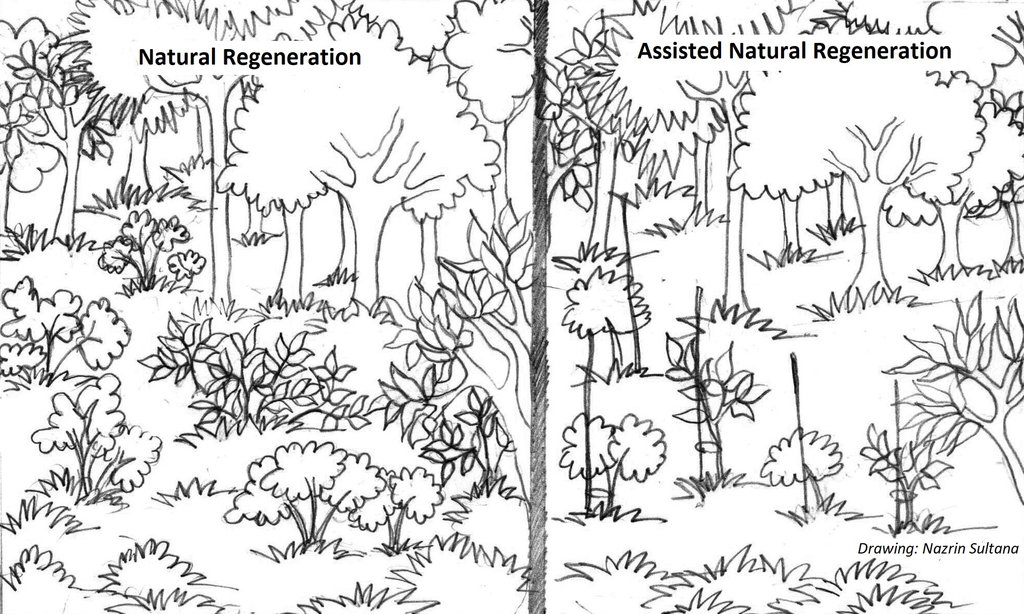Assisted Natural Regeneration [บังกลาเทศ]
- ผู้สร้างสรรค์:
- การอัพเดท:
- ผู้รวบรวม: Fazlay Arafat
- ผู้เรียบเรียง: –
- ผู้ตรวจสอบ: Nicole Harari, Rima Mekdaschi Studer, Ursula Gaemperli
ANR
technologies_4372 - บังกลาเทศ
ดูส่วนย่อย
ขยายทั้งหมด ย่อทั้งหมด1. ข้อมูลทั่วไป
1.2 รายละเอียดที่ติดต่อได้ของผู้รวบรวมและองค์กรที่เกี่ยวข้องในการประเมินและการจัดเตรียมทำเอกสารของเทคโนโลยี
วิทยากรหลัก
ผู้ใช้ที่ดิน:
Morshed Hoq Mahabub
Bangladesh Forest Department
บังกลาเทศ
ผู้ใช้ที่ดิน:
Islam Md. Saiful
Bangladesh Forest Department
บังกลาเทศ
ผู้ใช้ที่ดิน:
Rahman Md.
Community Patrolling Group (CPG), Medhakocchopia
บังกลาเทศ
ชื่อของโครงการซึ่งอำนวยความสะดวกในการทำเอกสารหรือการประเมินเทคโนโลยี (ถ้าเกี่ยวข้อง)
Decision Support for Mainstreaming and Scaling out Sustainable Land Management (GEF-FAO / DS-SLM)ชื่อขององค์กรซึ่งอำนวยความสะดวกในการทำเอกสารหรือการประเมินเทคโนโลยี (ถ้าเกี่ยวข้อง)
Bangladesh Forest Department (Bangladesh Forest Department) - บังกลาเทศชื่อขององค์กรซึ่งอำนวยความสะดวกในการทำเอกสารหรือการประเมินเทคโนโลยี (ถ้าเกี่ยวข้อง)
FAO Bangladesh (FAO Bangladesh) - บังกลาเทศ1.3 เงื่อนไขการใช้ข้อมูลที่ได้บันทึกผ่านทาง WOCAT
ผู้รวบรวมและวิทยากรหลักยอมรับเงื่อนไขเกี่ยวกับการใช้ข้อมูลที่ถูกบันทึกผ่านทาง WOCAT:
ใช่
1.4 การเปิดเผยเรื่องความยั่งยืนของเทคโนโลยีที่ได้อธิบายไว้
เทคโนโลยีที่ได้อธิบายไว้นี้เป็นปัญหาของความเสื่อมโทรมโทรมของที่ดินหรือไม่ จึงไม่ได้รับการยอมรับว่าเป็นเทคโนโลยีเพื่อการจัดการที่ดินอย่างยั่งยืน:
ไม่ใช่
2. การอธิบายลักษณะของเทคโนโลยี SLM
2.1 การอธิบายแบบสั้น ๆ ของเทคโนโลยี
คำจำกัดความของเทคโนโลยี:
Assisted natural regeneration (ANR) is a simple, low-cost forest restoration method that can effectively convert deforested lands to more productive forests.
2.2 การอธิบายแบบละเอียดของเทคโนโลยี
คำอธิบาย:
Medhakachapia National Park (MKNP) is nationally known for protecting the most extensive stands of mature critically endangered Garjan (Dipterocarpus turbinatus) trees in Bangladesh. Other native trees present in MKNP include Telsur Hopea odorata, Boilam Anisoptera scaphula, Gamar Gmelina arborea and Chapalish Artocarpus chaplasha. MKNP is tropical semi-evergreen forest in the low hills of the Fulchari Forest Range and covers 396 hectares. The park is located in Chakaria Upazila, not far from Cox’s Bazar in the southeast part of the country. Originally, the entire park area was densely covered with Garjan forest, but now there are about 9000 mature Garjan trees as many parts have been encroached upon with agriculture. MKNP is bordered by 13 villages where most of the people depend directly or indirectly upon the forest. Encroachment by settlements and agriculture has been associated with illegal tree cutting, hunting, and collection of fuel wood, bamboo and cane and other forest products. These activities are encouraged by sawmills in the vicinity and unemployment. Due to reduced canopy coverage, the forest soils have been exposed degraded. In order to restore forest health, the Bangladesh Forest Department introduced Assisted Natural Regeneration (ANR) practice. The access for public recreation and education and research is allowed inside national park. However, the collection of fuel woods and non-timber forest product from national park area by the local communities is a common scenario here.
ANR aims to accelerate, rather than replace, natural succession processes by removing or reducing barriers to natural forest regeneration such as competition with weedy species and recurring disturbances (e.g., fuel wood collection, grazing, fire and wood harvesting). Compared to conventional reforestation methods, which involve planting tree seedlings, ANR offers the significant advantage avoiding costs associated with propagating, raising, and planting seedlings. ANR is most effectively utilized at the landscape level in restoring the forest protective functions, such as soil protection, and is most suitable for restoring areas where some level of natural succession is already in progress. ANR offers distinct advantages over other forest restoration methods but also has some limitations. ANR is much cheaper to implement and can be applied over larger areas than other restoration planting approaches, but may be less effective in enhancing floristic diversity at the initial stages. Some of ANR’s disadvantages can be overcome by enrichment planting with desirable species. ANR aims to accelerate, rather than replace natural succession process by removing or reducing barriers to natural forest regeneration.
Soil degradation of MKNP has been greatly reduced through practicing ANR and co-management. In MKNP co-management was established on 2009 engaging local communities. As a part of co-management activities, the Forest Department (FD) formed a Community Patrolling Group (CPG) with 35 members from the local community to protect the Garjan trees and look after the whole forest along with forester officers. Under the support from Climate-Resilient Ecosystems and Livelihoods (CREL) project of USAID, the CPG along with FD intensively patrol the forest in rotating groups to ensure that no harm is done to the mature trees and natural seedlings. As a result, sufficient tree regeneration is now taking place and their growth is accelerating. Even where weeds dominate, seedlings of pioneer tree species are often found. The minimum required number of preexisting seedlings to implement ANR depends on the acceptable length of time for the forest to be restored and site-specific conditions that influence the rate of forest recovery. As a general reference, a density range of 200–800 seedlings/ha (>15 cm in height; counting clumps in 1 m2 as one seedling) has been suggested for ANR reforestation, and it has been estimated that at least 700 seedlings/ha are needed during the early treatment period in order to achieve canopy closure within three years. Although the forest restored through ANR in MKNP will have lower commercial value in terms of timber, it will support greater biodiversity and more effectively provide for the subsistence needs of the local people compared to commercial plantations.
2.3 รูปภาพของเทคโนโลยี
2.5 ประเทศภูมิภาค หรือสถานที่ตั้งที่เทคโนโลยีได้นำไปใช้และได้รับการครอบคลุมโดยการประเมินนี้
ประเทศ:
บังกลาเทศ
ภูมิภาค/รัฐ/จังหวัด:
Chittagong division
ข้อมูลจำเพาะเพิ่มเติมของสถานที่ตั้ง :
Medakacchapia National Park under Cox's Bazar North Forest division
ระบุการกระจายตัวของเทคโนโลยี:
- กระจายไปอย่างสม่ำเสมอในพื้นที่
If precise area is not known, indicate approximate area covered:
- 1-10 ตร.กม.
Is/are the technology site(s) located in a permanently protected area?
ใช่
ถ้าใช่ ระบุ:
Medakacchapia is a National Park with an area of 395.92 ha. In Bangladesh, the access for public recreation and education/research is allowed inside national park. However, the collection of fuel woods and non-timber forest product from national park area by the local communities is a common scenario here.
Map
×2.6 วันที่การดำเนินการ
ระบุปีที่ใช้:
2014
2.7 คำแนะนำของเทคโนโลยี
ให้ระบุว่าเทคโนโลยีถูกแนะนำเข้ามาอย่างไร:
- ทางโครงการหรือจากภายนอก
ความคิดเห็น (ประเภทของโครงการ เป็นต้น) :
Climate-Resilient Ecosystems and Livelihoods (CREL) project of USAID
3. การจัดประเภทของเทคโนโลยี SLM
3.1 วัตถุประสงค์หลักของเทคโนโลยี
- ลด ป้องกัน ฟื้นฟู การเสื่อมโทรมของที่ดิน
- อนุรักษ์ระบบนิเวศน์
- รักษาสภาพหรือปรับปรุงความหลากหลายทางชีวภาพ
- สร้างผลกระทบทางด้านสังคมที่เป็นประโยชน์
3.2 ประเภทของการใช้ที่ดินในปัจจุบันที่ได้นำเทคโนโลยีไปใช้
Land use mixed within the same land unit:
ไม่ใช่

ป่า/พื้นที่ทำไม้
- ป่ากึ่งธรรมชาติ / พื้นที่ทำไม้
(Semi-)natural forests/ woodlands: Specify management type:
- การเอาไม้ที่ตายแล้วออกไปหรือการตัดแต่งกิ่ง
- Tropical semi-evergreen forest
- Dipterocarpus turbinatus, Syzygium grande, Chukrasia tabularis, Hopea odorata
Are the trees specified above deciduous or evergreen?
- mixed deciduous/ evergreen
ผลิตภัณฑ์และบริการ:
- ไม้ซุง
- ไม้ที่นำมาทำเป็นเชื้อเพลิง
- ผลไม้และถั่ว
- การอนุรักษ์ / ป้องกันธรรมชาติ
- นันทนาการ / การท่องเที่ยว
- Oil from Dipterocarpus turbinatus
3.3 Has land use changed due to the implementation of the Technology?
Has land use changed due to the implementation of the Technology?
- No (Continue with question 3.4)
3.4 การใช้น้ำ
การใช้น้ำของที่ดินที่มีการใช้เทคโนโลยีอยู่:
- จากน้ำฝน
3.5 กลุ่ม SLM ที่ตรงกับเทคโนโลยีนี้
- การจัดการป่าธรรมชาติและกึ่งธรรมชาติ
- การปรับปรุงดิน / พืชคลุมดิน
3.6 มาตรการ SLM ที่ประกอบกันเป็นเทคโนโลยี

มาตรการอนุรักษ์ด้วยวิธีพืช
- V1: ต้นไม้และพุ่มไม้คลุมดิน

มาตรการอนุรักษ์ด้วยการจัดการ
- M2: การเปลี่ยนแปลงของการจัดการหรือระดับความเข้มข้น
แสดงความคิดเห็น:
Earlier the ground vegetation was suppressed by weeds and non-valuable plant species. Various alien invasive plant species also disturbed the natural succession process of these area. The management practice also changed from plantation in vacant area to assisted natural regeneration with the involvement of local community.
3.7 รูปแบบหลักของการเสื่อมโทรมของที่ดินที่ได้รับการแก้ไขโดยเทคโนโลยี

การกัดกร่อนของดินโดยน้ำ
- Wt (Loss of topsoil): การสูญเสียดินชั้นบนหรือการกัดกร่อนที่ผิวดิน
- Wg (Gully erosion): การกัดกร่อนแบบร่องธารหรือการทำให้เกิดร่องน้ำเซาะ

การเสื่อมโทรมของดินทางด้านชีวภาพ
- Bc (Reduction of vegetation cover): การลดลงของจำนวนพืชที่ปกคลุมดิน
- Bq (Quantity/biomass decline): การลดลงของปริมาณหรือมวลชีวภาพ
- Bs (Quality and species composition): องค์ประกอบหรือความหลากหลายทางคุณภาพและชนิดพันธุ์ลดลง
3.8 การป้องกัน การลดลง หรือการฟื้นฟูความเสื่อมโทรมของที่ดิน
ระบุเป้าหมายของเทคโนโลยีกับความเสื่อมโทรมของที่ดิน:
- ลดความเสื่อมโทรมของดิน
แสดงความคิดเห็น:
Canopy coverage of the area were poor and top soil erosion occurred due to exposed forest cover. Through ANR the canopy coverage will be regained and reduce land degradation.
4. ข้อมูลจำเพาะด้านเทคนิค กิจกรรมการนำไปปฏิบัติใช้ ปัจจัยนำเข้า และค่าใช้จ่าย
4.1 แบบแปลนทางเทคนิคของเทคโนโลยี
ข้อมูลจำเพาะด้านเทคนิค (แบบแปลนทางเทคนิคของเทคโนโลยี):
Step 1: Marking of Woody Regeneration
Once the target area is identified and its boundaries are demarcated, the site is surveyed to assess its succession status and to locate any natural woody regeneration growing in the weedy vegetation. The located seedlings should be clearly marked with stakes. Decision on the minimum size of seedlings to be protected and released depends on the density and distribution of seedlings in the area, as well as budget and time constraints. However, the seedlings should be large enough to have a reasonable chance of survival.
Step 2: Liberation and Tending of Woody Regeneration
The next step is to accelerate the growth of the marked seedlings by reducing competition from the weedy species for water, nutrients, and light. The initial weeding and climber cutting should be implemented at the onset of the rainy season so that the liberated seedlings will have the full growing season of accelerated growth. All competing vegetation such as weeds and climbers within at least 0.5 m radius around the stem of the marked seedlings are removed. In some cases, clumps of woody seedlings may need to be thinned in order to liberate the largest individuals or the more desirable species.
Step 3: Protection from Disturbance.
Protecting against fire and other forms of disturbance is the most important ANR activity. Establishing firebreaks around blocks of ANR-treated sites is important, if the area is prone to fire. If animal grazing is prevalent in the area, fencing should be established, or patrols/guards should be assigned to protect the site from such activity. Long-term community involvement and support is critical in preventing the re-occurrence of disturbance events that will set back succession to the before-treatment state.
Step 4: Maintenance and Enrichment Planting.
It is suggested that the maintenance of weeding, and liberation of any additional seedlings that establish or that are newly found, should be conducted three times in first two years and two times in next two years. In the fifth year one climber cutting should be conducted in rainy season. The frequency of maintenance operations can be adjusted according to field observation and monitoring data on the growth of the liberated seedlings and the density of natural woody regeneration. Enrichment planting can also be carried out to accelerate canopy closure, add useful tree species, and increase floral diversity. Even after the restoration of canopy cover, large-seeded primary forest trees and rare species are unlikely to colonize naturally. If restoring some of the floral diversity of the original forest is one of the restoration objectives, species or functional groups of trees lacking in natural regeneration will need to be planted either at the initial treatment stage or after canopy closure depending on the ecological requirements of the species.
ผู้เขียน:
Nazrin Sultana
วันที่:
16/04/2019
4.2 ข้อมูลทั่วไปเกี่ยวกับการคำนวณปัจจัยนำเข้าและค่าใช้จ่าย
ให้ระบุว่าค่าใช้จ่ายและปัจจัยนำเข้าได้รับการคำนวณอย่างไร:
- ต่อพื้นที่ที่ใช้เทคโนโลยี
ระบุขนาดและหน่วยพื้นที่:
1 hectare
If using a local area unit, indicate conversion factor to one hectare (e.g. 1 ha = 2.47 acres): 1 ha =:
1 ha = 2.47 acres
อื่นๆ หรือสกุลเงินประจำชาติ (ระบุ):
BDT
If relevant, indicate exchange rate from USD to local currency (e.g. 1 USD = 79.9 Brazilian Real): 1 USD =:
84.0
ระบุค่าเฉลี่ยของค่าจ้างในการจ้างแรงงานต่อวัน:
500 BDT
4.3 กิจกรรมเพื่อการจัดตั้ง
| กิจกรรม | Timing (season) | |
|---|---|---|
| 1. | Site preparation (Boundary demarcation, site map preparation with GPS, marking of woody regeneration) | May-June |
| 2. | Care and maintenance of natural regeneration (liberation and tending of woody regeneration, protection from disturbance) | June-July |
4.4 ค่าใช้จ่ายของปัจจัยนำเข้าที่จำเป็นสำหรับการจัดตั้ง
| ปัจจัยนำเข้า | หน่วย | ปริมาณ | ค่าใช้จ่ายต่อหน่วย | ค่าใช้จ่ายทั้งหมดต่อปัจจัยนำเข้า | %ของค่าใช้จ่ายที่ก่อให้เกิดขึ้นโดยผู้ใช้ที่ดิน | |
|---|---|---|---|---|---|---|
| แรงงาน | Survey for map preparation and marking of woody regeneration | person-days | 1.0 | 500.0 | 500.0 | |
| แรงงาน | Tying up seedlings and young trees | person-days | 4.0 | 500.0 | 2000.0 | |
| แรงงาน | Tending of woody regeneration | person-days | 10.0 | 500.0 | 5000.0 | |
| แรงงาน | Application of fertilizers | person-days | 4.0 | 500.0 | 2000.0 | |
| อุปกรณ์ | Weeding equipment (manual weeding tool) | lump sum | 1.0 | 1000.0 | 1000.0 | |
| อุปกรณ์ | Bamboo sticks for tying up seedlings | pieces | 800.0 | 2.0 | 1600.0 | |
| อุปกรณ์ | Rope | lump sum | 1.0 | 1000.0 | 1000.0 | |
| ปุ๋ยและสารฆ่า/ยับยั้งการเจริญเติบโตของสิ่งมีชีวิต (ไบโอไซด์) | Compost fertilizer | Kg | 625.0 | 4.0 | 2500.0 | |
| วัสดุสำหรับก่อสร้าง | Rod, Cement, Sand, Khoa, etc for RCC signboard | Lump sum | 1.0 | 1000.0 | 1000.0 | |
| ค่าใช้จ่ายทั้งหมดของการจัดตั้งเทคโนโลยี | 16600.0 | |||||
| Total costs for establishment of the Technology in USD | 197.62 | |||||
ถ้าผู้ใช้ที่ดินรับภาระน้อยกว่า 100% ของค่าใช้จ่าย ให้ระบุว่าใครเป็นผู้รับผิดชอบส่วนที่เหลือ:
Bangladesh forest department is the land user and the total cost of the establishment borne by CREL project
4.5 การบำรุงรักษาสภาพหรือกิจกรรมที่เกิดขึ้นเป็นประจำ
| กิจกรรม | ช่วงระยะเวลา/ความถี่ | |
|---|---|---|
| 1. | 1st year weeding | 3 times |
| 2. | 2nd year weeding | 3 times |
| 3. | 3rd year weeding | 2 times |
| 4. | 4th year weeding | 2 times |
| 5. | 5th year climber cutting | 1 time |
4.6 ค่าใช้จ่ายของปัจจัยนำเข้าและกิจกรรมที่เกิดขึ้นเป็นประจำที่ต้องการการบำรุงรักษา (ต่อปี)
| ปัจจัยนำเข้า | หน่วย | ปริมาณ | ค่าใช้จ่ายต่อหน่วย | ค่าใช้จ่ายทั้งหมดต่อปัจจัยนำเข้า | %ของค่าใช้จ่ายที่ก่อให้เกิดขึ้นโดยผู้ใช้ที่ดิน | |
|---|---|---|---|---|---|---|
| แรงงาน | 1st year weeding | person-days | 15.0 | 500.0 | 7500.0 | |
| แรงงาน | 2nd year weeding | person-days | 15.0 | 500.0 | 7500.0 | |
| แรงงาน | 3rd year weeding | person-days | 10.0 | 500.0 | 5000.0 | |
| แรงงาน | 4th year weeding and 5th year climber cutting | person-days | 15.0 | 500.0 | 7500.0 | 100.0 |
| อุปกรณ์ | Weeding equipment (manual weeding tools) | lump sum | 1.0 | 1000.0 | 1000.0 | |
| ค่าใช้จ่ายทั้งหมดของการบำรุงรักษาสภาพเทคโนโลยี | 28500.0 | |||||
| Total costs for maintenance of the Technology in USD | 339.29 | |||||
ถ้าผู้ใช้ที่ดินรับภาระน้อยกว่า 100% ของค่าใช้จ่าย ให้ระบุว่าใครเป็นผู้รับผิดชอบส่วนที่เหลือ:
The 4th year weeding and 5th year climber cutting borne by forest department
4.7 ปัจจัยสำคัญที่สุดที่มีผลกระทบต่อค่าใช้จ่าย
ปัจจัยสำคัญที่สุดที่มีผลกระทบต่อค่าใช้จ่ายต่างๆ:
The most important factor affecting the costs is labor
5. สิ่งแวดล้อมทางธรรมชาติและของมนุษย์
5.1 ภูมิอากาศ
ฝนประจำปี
- < 250 ม.ม.
- 251-500 ม.ม.
- 501-750 ม.ม.
- 751-1,000 ม.ม.
- 1,001-1,500 ม.ม.
- 1,501-2,000 ม.ม.
- 2,001-3,000 ม.ม.
- 3,001-4,000 ม.ม.
- > 4,000 ม.ม.
ระบุปริมาณน้ำฝนเฉลี่ยรายปี (ถ้ารู้) :หน่วย ม.ม.
3770.00
ข้อมูลจำเพาะ/ความคิดเห็นเรื่องปริมาณน้ำฝน:
The driest month is December. The greatest amount of precipitation occurs in June.
เขตภูมิอากาศเกษตร
- ชื้น
Mean annual temperature is 25.6 °C
5.2 สภาพภูมิประเทศ
ค่าเฉลี่ยความลาดชัน:
- ราบเรียบ (0-2%)
- ลาดที่ไม่ชัน (3-5%)
- ปานกลาง (6-10%)
- เป็นลูกคลื่น (11-15%)
- เป็นเนิน (16-30%)
- ชัน (31-60%)
- ชันมาก (>60%)
ธรณีสัณฐาน:
- ที่ราบสูง/ที่ราบ
- สันเขา
- ไหล่เขา
- ไหล่เนินเขา
- ตีนเนิน
- หุบเขา
ระดับความสูง:
- 0-100 เมตร
- 101-500 เมตร
- 501-1,000 เมตร
- 1,001-1,500 เมตร
- 1,501-2,000 เมตร
- 2,001-2,500 เมตร
- 2,501-3,000 เมตร
- 3,001-4,000 เมตร
- > 4,000 เมตร
ให้ระบุถ้าเทคโนโลยีได้ถูกนำไปใช้:
- ไม่เกี่ยวข้อง
5.3 ดิน
ค่าเฉลี่ยความลึกของดิน:
- ตื้นมาก (0-20 ซ.ม.)
- ตื้น (21-50 ซ.ม.)
- ลึกปานกลาง (51-80 ซ.ม.)
- ลึก (81-120 ซ.ม.)
- ลึกมาก (>120 ซ.ม.)
เนื้อดิน (ดินชั้นบน):
- ปานกลาง (ดินร่วน ทรายแป้ง)
เนื้อดินล่าง (> 20 ซ.ม.ต่ำจากผิวดิน):
- ปานกลาง (ดินร่วน ทรายแป้ง)
อินทรียวัตถุในดิน:
- ปานกลาง (1-3%)
5.4 ความเป็นประโยชน์และคุณภาพของน้ำ
ระดับน้ำใต้ดิน:
5-50 เมตร
น้ำไหลบ่าที่ผิวดิน:
ดี
คุณภาพน้ำ (ที่ยังไม่ได้บำบัด):
เป็นน้ำเพื่อการดื่มที่ไม่ดี (จำเป็นต้องได้รับการบำบัด)
Water quality refers to:
surface water
ความเค็มของน้ำเป็นปัญหาหรือไม่:
ไม่ใช่
กำลังเกิดน้ำท่วมในพื้นที่หรือไม่:
ไม่ใช่
5.5 ความหลากหลายทางชีวภาพ
ความหลากหลายทางชนิดพันธุ์:
- ปานกลาง
ความหลากหลายของแหล่งที่อยู่:
- ปานกลาง
5.6 ลักษณะของผู้ใช้ที่ดินที่นำเทคโนโลยีไปปฏิบัติใช้
อยู่กับที่หรือเร่ร่อน:
- อยู่กับที่
แนวทางการตลาดของระบบการผลิต:
- mixed (subsistence/ commercial)
รายได้ที่มาจากนอกฟาร์ม:
- < 10% ของรายได้ทั้งหมด
ระดับของความมั่งคั่งโดยเปรียบเทียบ:
- จน
เป็นรายบุคคล/ครัวเรือน:
- ลูกจ้าง (บริษัท รัฐบาล)
ระดับของการใช้เครื่องจักรกล:
- งานที่ใช้แรงกาย
เพศ:
- หญิง
- ชาย
อายุของผู้ใช้ที่ดิน:
- ผู้เยาว์
- วัยกลางคน
- ผู้สูงอายุ
5.7 Average area of land used by land users applying the Technology
- < 0.5 เฮกตาร์
- 0.5-1 เฮกตาร์
- 1-2 เฮกตาร์
- 2-5 เฮกตาร์
- 5-15 เฮกตาร์
- 15-50 เฮกตาร์
- 50-100 เฮกตาร์
- 100-500 เฮกตาร์
- 500-1,000 เฮกตาร์
- 1,000-10,000 เฮกตาร์
- >10,000 เฮกตาร์
พิจารณาว่าเป็นขนาดเล็ก กลาง หรือขนาดใหญ่ (ซึ่งอ้างอิงถึงบริบทระดับท้องถิ่น):
- ขนาดเล็ก
5.8 กรรมสิทธิ์ในที่ดิน สิทธิในการใช้ที่ดินและสิทธิในการใช้น้ำ
กรรมสิทธิ์ในที่ดิน:
- รัฐ
สิทธิในการใช้ที่ดิน:
- เกี่ยวกับชุมชน (ถูกจัดระเบียบ)
สิทธิในการใช้น้ำ:
- เข้าถึงได้แบบเปิด (ไม่ได้จัดระเบียบ)
Are land use rights based on a traditional legal system?
ไม่ใช่
ระบุ:
Under co-management system
แสดงความคิดเห็น:
Co-management of forest ensures active participation of all concerned parties in the management or maintenance of natural resources on the basis of consensus among the stakeholders involved in the management of the natural resources of an area
5.9 การเข้าถึงบริการและโครงสร้างพื้นฐาน
สุขภาพ:
- จน
- ปานกลาง
- ดี
การศึกษา:
- จน
- ปานกลาง
- ดี
ความช่วยเหลือทางด้านเทคนิค:
- จน
- ปานกลาง
- ดี
การจ้างงาน (เช่น ภายนอกฟาร์ม):
- จน
- ปานกลาง
- ดี
ตลาด:
- จน
- ปานกลาง
- ดี
พลังงาน:
- จน
- ปานกลาง
- ดี
ถนนและการขนส่ง:
- จน
- ปานกลาง
- ดี
น้ำดื่มและการสุขาภิบาล:
- จน
- ปานกลาง
- ดี
บริการด้านการเงิน:
- จน
- ปานกลาง
- ดี
6. ผลกระทบและสรุปคำบอกกล่าว
6.1 ผลกระทบในพื้นที่ดำเนินการ (On-site) จากการใช้เทคโนโลยี
ผลกระทบทางด้านเศรษฐกิจและสังคม
การผลิต
การผลิตไม้
แสดงความคิดเห็น/ระบุ:
ANR support the growth of woody vegetation and regular monitoring of ANR also provide security to the mature trees of the stand
คุณภาพป่า /พื้นที่ทำไม้
การผลิตของจากป่าทุกชนิดยกเว้นไม้
การเสี่ยงต่อความล้มเหลวในการผลิต
พื้นที่สำหรับการผลิต
แสดงความคิดเห็น/ระบุ:
Through ANR the fellow and degraded forest land now bring under productive forest
การจัดการที่ดิน
แสดงความคิดเห็น/ระบุ:
ANR is a comparatively easy method than clear felling with artificial regeneration, mixed plantation or enrichment plantation to manage forest area
รายได้และค่าใช้จ่าย
ความหลากหลายของแหล่งผลิตรายได้
แสดงความคิดเห็น/ระบุ:
The local communities can collect NTFP from the ANR site. Due to the increase of vegetation and presence of wildlife in MKNP, the area also attract tourists. The CPG people also worked as tourist guide
ผลกระทบด้านสังคมวัฒนธรรมอื่น ๆ
โอกาสทางวัฒนธรรม
แสดงความคิดเห็น/ระบุ:
aesthetic beauty of forest improved
โอกาสทางด้านสันทนาการ
แสดงความคิดเห็น/ระบุ:
eco-tourism increased
SLM หรือความรู้เรื่องความเสื่อมโทรมของที่ดิน
สถานการณ์ของกลุ่มด้อยโอกาส ทางด้านสังคมและเศรษฐกิจ
แสดงความคิดเห็น/ระบุ:
Poor people working in Community Patrolling Group (CPG) taking care of ANR with forest department. Social status of these poor people improved.
ผลกระทบด้านนิเวศวิทยา
วัฐจักรน้ำหรือน้ำบ่า
น้ำไหลบ่าที่ผิวดิน
น้ำบาดาลหรือระดับน้ำในแอ่งน้ำบาดาล
การระเหย
แสดงความคิดเห็น/ระบุ:
Due to increased canopy coverage evaporation decreased
ดิน
ความชื้นในดิน
สิ่งปกคลุมดิน
การสูญเสียดิน
การหมุนเวียนและการเติมของธาตุอาหาร
อินทรียวัตถุในดิน/ต่ำกว่าดินชั้น C
ความหลากหลายทางชีวภาพของพืชและสัตว์
การปกคลุมด้วยพืช
มวลชีวภาพ/เหนือดินชั้น C
ความหลากหลายทางชีวภาพของพืช
พืชพันธุ์ต่างถิ่นที่รุกล้ำเข้ามา
แสดงความคิดเห็น/ระบุ:
Through ANR only native plant species promoted to grow here
ความหลากหลายทางชีวภาพของสัตว์
แสดงความคิดเห็น/ระบุ:
Animal diversity increased as the habitat improved
ชนิดพันธุ์ที่ให้ประโยชน์
ความหลากหลายของสัตว์
แสดงความคิดเห็น/ระบุ:
habitat diversity increased with the canopy coverage and tree density improvement
ลดความเสี่ยงของภัยพิบัติ
ดินถล่ม/ ซากต่าง ๆ ที่ถูกพัดพามา
การปล่อยคาร์บอนและก๊าซเรือนกระจก
6.2 ผลกระทบนอกพื้นที่ดำเนินการ (Off-site) จากการใช้เทคโนโลยี
การไหลของน้ำคงที่และสม่ำเสมอในช่วงฤดูแล้ง
แสดงความคิดเห็น/ระบุ:
Due to the presence of vegetation on slope the stream flow become stable
การทับถมของดินตะกอนพื้นที่ท้ายน้ำ
ผลกระทบของก๊าซเรือนกระจก
6.3 การเผชิญและความตอบสนองของเทคโนโลยีต่อการเปลี่ยนแปลงสภาพภูมิอากาศที่ค่อยเป็นค่อยไป และสภาพรุนแรงของภูมิอากาศ / ภัยพิบัติ (ที่รับรู้ได้โดยผู้ใช้ที่ดิน)
การเปลี่ยนแปลงสภาพภูมิอากาศที่ค่อยเป็นค่อยไป
การเปลี่ยนแปลงสภาพภูมิอากาศที่ค่อยเป็นค่อยไป
| ฤดู | increase or decrease | เทคโนโลยีมีวิธีการรับมืออย่างไร | |
|---|---|---|---|
| อุณหภูมิประจำปี | เพิ่มขึ้น | ดี | |
| อุณหภูมิตามฤดูกาล | ฤดูร้อน | เพิ่มขึ้น | ดี |
| ฝนประจำปี | ลดลง | ปานกลาง | |
| ฝนตามฤดู | ฤดูฝน | เพิ่มขึ้น | ปานกลาง |
สภาพรุนแรงของภูมิอากาศ (ภัยพิบัติ)
ภัยพิบัติจากน้ำ
| เทคโนโลยีมีวิธีการรับมืออย่างไร | |
|---|---|
| ดินถล่ม | ไม่ค่อยดี |
แสดงความคิดเห็น:
Note to coping with landslides; Due to the events of landslides in the upper slope sometimes the seedlings and young trees suffered at the foot slope. The degraded upland area can be recovered through ANR with enrichment planting to reduces the events of landslides and slope stabilization.
6.4 การวิเคราะห์ค่าใช้จ่ายและผลประโยชน์ที่ได้รับ
ผลประโยชน์ที่ได้รับเปรียบเทียบกับค่าใช้จ่ายในการจัดตั้งเป็นอย่างไร (จากมุมมองของผู้ใช้ที่ดิน)
ผลตอบแทนระยะสั้น:
ด้านลบเล็กน้อย
ผลตอบแทนระยะยาว:
ด้านบวกอย่างมาก
ผลประโยชน์ที่ได้รับเปรียบเทียบกับค่าใช้จ่ายในการบำรุงรักษาหรือต้นทุนที่เกิดขึ้นซ้ำอีก เป็นอย่างไร (จากมุมมองของผู้ใช้ที่ดิน)
ผลตอบแทนระยะสั้น:
ด้านลบเล็กน้อย
ผลตอบแทนระยะยาว:
ด้านบวกอย่างมาก
6.5 การปรับตัวของเทคโนโลยี
- 1-10%
Of all those who have adopted the Technology, how many did so spontaneously, i.e. without receiving any material incentives/ payments?
- 91-100%
6.6 การปรับตัว
เทคโนโลยีได้รับการปรับเปลี่ยนเมื่อเร็วๆนี้ เพื่อให้ปรับตัวเข้ากับสภาพที่กำลังเปลี่ยนแปลงหรือไม่:
ไม่ใช่
6.7 จุดแข็ง / ข้อได้เปรียบ / โอกาสของเทคโนโลยี
| จุดแข็ง / ข้อได้เปรียบ / โอกาสในทัศนคติของผู้ใช้ที่ดิน |
|---|
| It is a low cost intervention to regain the protective roles of the forest. |
| Community Patrolling Group (CPG) are involved in maintenance of ANR forest through co-management of natural resources. Regular patrolling activity reduces the disturbance in forest and help to prevent land degradation. |
| จุดแข็ง / ข้อได้เปรียบ / โอกาสในทัศนคติของผู้รวบรวมหรือวิทยากรหลัก |
|---|
| Biodiversity conservation and wildlife habitat restoration are accelerated through ANR. |
6.8 จุดอ่อน / ข้อเสียเปรียบ / ความเสี่ยงของเทคโนโลยีและวิธีการแก้ไข
| จุดอ่อน / ข้อเสียเปรียบ / ความเสี่ยงในทัศนคติของผู้ใช้ที่ดิน | มีวิธีการแก้ไขได้อย่างไร |
|---|---|
| ANR is less effective in enhancing floral diversity than techniques e.g. mixed plantation, enrichment plantation, selection cum improvement etc. It promotes the existing regeneration and significant portion of regeneration comes from the dominant trees of the stand. | Enrichment plantations with ANR can increase the floral diversity. |
| The forest restored through ANR may have less commercial value in terms of timber compared to commercial plantation. This weakness of ANR is only valid for the forest which is managed for production purpose. | Desirable timber species can be planted as enrichment with ANR. |
| จุดอ่อน / ข้อเสียเปรียบ / ความเสี่ยงในทัศนคติของผู้รวบรวมหรือวิทยากรหลัก | มีวิธีการแก้ไขได้อย่างไร |
|---|---|
| ANR is suitable for areas where some level of natural succession is in progress. This, because sufficient tree regeneration must be present on the targeted site so their growth can be accelerate through ANR. | Plantation activity with other restoration method should be practiced where natural succession is low or absent. |
7. การอ้างอิงและการเชื่อมต่อ
7.1 วิธีการและแหล่งข้อมูล
- ไปเยี่ยมชมภาคสนาม การสำรวจพื้นที่ภาคสนาม
number of informants: 04
- การสัมภาษณ์กับผู้ใช้ที่ดิน
number of informants: 03
- การสัมภาษณ์ผู้เชี่ยวชาญด้าน SLM หรือผู้ชำนาญ
number of informants: 02
- การเก็บรวบรวมมาจากรายงานและเอกสารที่มีอยู่
number of informants: 02
วันที่เก็บรวบรวมข้อมูล(ภาคสนาม) :
15/01/2019
7.2 การอ้างอิงถึงสิ่งตีพิมพ์
หัวข้อ, ผู้เขียน, ปี, หมายเลข ISBN:
Shono, K., E. A. Cadaweng & P. B. Durst (2007) Application of assisted natural regeneration to restore degraded tropical forestlands. Restoration Ecology, 15, 620-626.
ชื่อเรื่อง ผู้เขียน ปี ISBN:
http://www.fao.org/forestry/19102-0bf30dd3d800687636a5ddc85e409044a.pdf
7.3 Links to relevant online information
ชื่อเรื่องหรือคำอธิบาย:
Medhakachapia National Park
URL:
http://nishorgo.org/project/medhakachapia-national-park/
7.4 General comments
The WOCAT questionnaire covers all the technical aspects of this SLM practice
ลิงก์และโมดูล
ขยายทั้งหมด ย่อทั้งหมดลิงก์
ไม่มีลิงก์
โมดูล
ไม่มีโมดูล


